°Arcus°
Home » Creation stories » Southern Africa
CREATION STORIES FROM SOUTHERN AFRICA
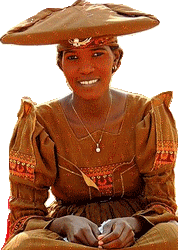
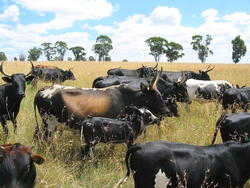
HERERO
The husband and wife pair Makuru and Kamungarunga descended from the roots of the cosmic tree Omumborombonga, a leadwood, also termed "father of life." Cattle also have their origin in the roots of Omumborombonga, why humans and other animals are descendants of flowers and originally crawled forth from the earth.
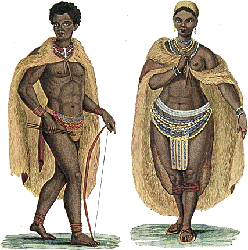
KHOEKHOE
The mythology of the Khoekhoe give an exalted status to the moon, which is seen as a visible representation of the invisible creator. The Nama give the name of Thiǁoab or Tsuiǁgoab to a demiurgic or creator figure, who is opposed by the nefarious ǁGaunab, the cause of sickness and death. Thiǁoab is also seen as the ancestor of the Khoekhoe and is associated with clouds, thunder and lightning.
Tsuiǁgoab is also revered by the Xhosa under the name of Thixo.
LOZI
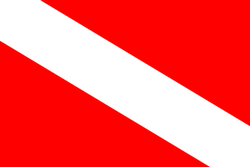
In the beginning, Nyambe dwelt alone in the universe. He created the earth to serve as a home for himself and Nasilele, his wife. He created the rivers, plants, animals and the first people: a man, Kamunu, and his wife. Kamunu learned quickly and it became clear to Nyambe that he was the most intelligent of his creations.
Eventually, though, Kamunu's cleverness got him into trouble: he learned how to make weapons, fashioning a spear, which he used to kill the antelope's son, which he ate. Nyambe was incensed and told Kamunu that he had killed his own brother, before sending him into exile for a year.
Kamunu returned, bearing a magical pot and a club. Nyambe got wind of this, but allowed Kamunu to remain in the land. Kamunu subsequently went to Nyambe to appeal for lands to cultivate, which were granted. These, however, were trampled by the buffalo one night, leading Kamunu to kill one of their number. With Nyambe's permission, Kamunu ate his kill. However, this caused Kamunu's magic pot to die, which Nyambe said was the way of things.
Next, the deer trampled his fields, and Kamunu responded in his usual fashion. Again, he ate the kill by Nyambe's leave. The following day, however, Kamunu's dog died. Kamunu was, however, unconcerned.
Later on, Kamunu maintained that he had witnessed Nyambe with both the pot and the dog, though his wife gave him short shrift.
The next animal which strayed onto Kamunu's lands was an elephant. This resulted, after the usual eating, in the demise of Kamunu's child, much to the man's chagrin.
After this, Nyambe took his messenger and the antelope to live on an island, away from Kamunu, but Kamunu built a canoe and went to Nyambe's new dwelling place. He bore offerings of meat for the creator, but Nyambe was disgusted and refused to eat them, claiming they were his children.
Next, Nyambe sought refuge on a mountain, but Kamunu again followed him. By this stage, Kamunu's children were growing in numbers, and Nyambe was unable to find anywhere to live without being disturbed by their actions, until he came to one particular place, to which he invited the animals. The animals, however, decided to stay where they were, trusting their superior speed and power to keep them safe from the humans.
In the end, Nyambe departed for the heavens. Again, Kamunu was unwilling to leave him be, trying to build a wooden tower to get there. This collapsed and resulted in the deaths of many people.
SAN (ǀXAM)
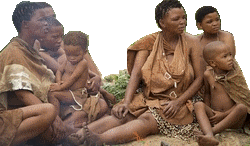
In the beginning, both humans and animals dwelt in peace with the Great Master Kaang, the Lord of All Life beneath the surface of the earth. This was a time when there was no want and the land was always bathed in light, despite there being no sun. Kaang, meanwhile, began to formulate a plan for the development of the surface world above. His first act was the creation of a tree whose branches provided cover for the whole world. He dug a hole at its base to enable access to and from the domain beneath where the humans and animals dwelt.
Upon completing his work of ordering the surface world, he led the first man up through the hole, followed in short order by the first woman. In a while, the whole human race was gathered around Kaang, who was sitting at the base of the tree. Thereafter, Kaang assisted the animals in their endeavour to join the humans on the surface. Some were so keen that they found other means of ingress, climbing up through the roots and emerging from the branches.
Once the population of the surface was complete, Kaang taught the people and animals to continue living in harmony as before, warning the humans not to make fires, lest a great misfortune befall them. Once this was done, Kaang left to watch the world from afar.
However, this new world was illuminated by the sun, with the corollary that there would be a sunset. As the evening passed into night, the humans became alarmed at their new-found vulnerability: their night vision was poor and they had no claws or thick hides to defend against any evil which might be lurking in the darkness. Their lack of fur too caused them to feel the bitter cold of night.
Forgetting Kaang's warning, the humans heeded the advice of one of their number, who had suggested they build a fire to furnish them with light and heat. Kaang's warning, however, came to fruition, as the animals, panicked by the fire, fled into the mountains and caves. Humans and animals could no longer communicate with one another, and a wariness now existed where friendship once reigned.
A ǀXAM PANTHEON
The "Kaang" of the account paraphrased above is very likely identified with a figure otherwise rendered ǀKágge̥n, ǀKaggən or Cagn, regarded as a mantis with shapeshifting abilities. ǀKágge̥n was the husband of ǀHúnntuǃattǃatte̥n and together they were the parents of a daughter, Porcupine. ǀHúnntuǃattǃatte̥n also bears the title "mother of bees." Other children of ǀKágge̥n and ǀHúnntuǃattǃatte̥n were Cogaz, Gewi and the bull eland. Porcupine married the meerkat Kwammang-a and they had a son, the mongoose Ichneumon who led his meerkat brothers in an effort to find honey which resulted in the death of the bull eland. Other deities include ǂKá̦gára or ǂKá'gára and his brother-in-law and rival ǃHãunu. One day, when ǂKá̦gára went to fetch his sister, her husband ǃHãunu pursued them, throwing lightning at the siblings. In response, ǂKá̦gára retaliated in the same manner. While ǃHãunu was mortally wounded, ǂKá̦gára was merely exhausted. The pair thundered after their battle, thus producing the meteorological effects associated with storms.
SHONA
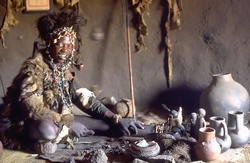
The Shona are a people of Zimbabwe. These stories are associated with the Karanga and Hungwe clans.
In the beginning, Maori made Mwuetsi, the first man, placing him deep beneath the primordial waters of Dsivoa. Mwuetsi was the moon. Mwuetsi, however, wished to dwell on earth and was accorded this dignity. Sadly, the earth was barren in those days, which led Maori to send him Massassi, a woman, to keep Mwuetsi company. Massassi is the morning star.
Mwutesi, however, was perplexed as to why Maori had sent him a woman. Massassi had made a fire and the couple were on either side. Mwuetsi took the ngona horn he had been given by Maori when he was in Dsivoa and put some oil on his finger, whereupon he leapt over the fire and daubed it upon Massassi. By the morning, Massassi was enormous, and began to bear all of the plant life which soon covered the earth. The pair lived well for a time, until, after two years, Maori took Massassi away.
This led Mwuetsi to weep for the next eight years. Maori sent him another woman, Morongo, the evening star. Mwuetsi touched her with an oily finger, but she told him that they would need to have intercourse to procreate. This they did every night thereafter, producing animals every morning. By the fourth morning, she gave birth to the first human children. That night, however, Maori dispatched a storm and told Mwuetsi that such activities would lead to his death. Morongo told her mate to build a door to prevent Maori from seeing the pair in action. The morning after, she gave birth to lions, leopards, snakes and scorpions. That night, Morongo told Mwuetsi to have sex with his daughters and he obliged, causing them to bear the ancestors of the Shona. Mwuetsi became the Mambo or great chief of the people and dwelt within the magnificent Great Zimbabwe.
Morongo, however, was still as lecherous as ever, and ended up having intercourse with a serpent. Eventually, this new love of hers would prove Mwuetsi's downfall: he went in unto Morongo, only for the snake to bite him. His subsequent illness caused the earth to become arid and it transpired that he needed to return to Dsivoa to save the world. Thus, Mwuetsi's children strangled him to death, burying Morongo alongside him.
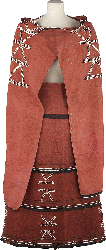
XHOSA
Thixo, a sun god, was the earliest being known to the Xhosa. He is possibly identical to (or the father of) Qamatha, to whom the Xhosa credit the work of creation. This Qamatha is a mysterious figure, about whom the Xhosa profess to knowing little.
YAO
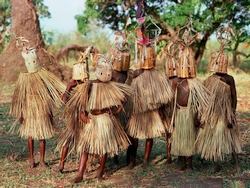
In the beginning, water covered the cosmos. Mulungu dwelt amidst this primordial ocean with the various animals.
After some time, Chameleon let down a fishing net. When he drew it up, a tiny man and woman were discovered. He took the net and people to Mulungu, who told him to release them, so that they could grow.
Eventually, these people grew to normative proportions and learned the mastery of fire. Unfortunately, their habit of setting forests on fire for the purposes of hunting terrified the other animals.
This turn of events disgusted Mulungu to such an extent that he asked a spider to spin a thread to enable him to escape to the heavens, where he remains with the other gods to this day.
ZULU
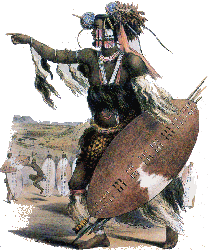
The first human beings, having been formed by Unkulunkulu, existed alongside cattle in an area in which reeds were abundant, named Uhlanga. This came into being at the beginning of time, when the Supreme Creator fashioned the earth and the seas. He proceeded to teach the Zulu how to survive on the surface of the earth, by making fire, hunting, gathering and growing food.
Unkulunkulu's wife was Nomkhubulwane, who had the ability to change her shape into that of any animal. She was the goddess of rain, the rainbow, agriculture and beer. The son of Unkulunkulu and Nomkhubulwane was UMvelinqangi, also known as Unsondo, the god of the sky, thunder and earthquakes. His name means "he who was in the very beginning."
